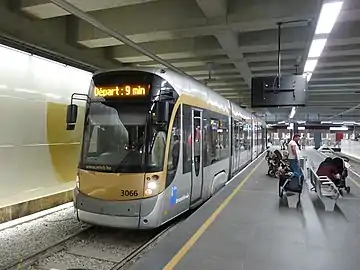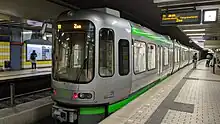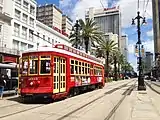Semi-metro
Semi-metro (also known as subway-surface[1][2][3] line or hybrid[4] streetcar/lightrail line) is a form of public rail transport in which trams run partly on a conflict-free track, by using tunnels and/or viaducts.[5] These stretches of track are designed to function like a regular metro or rapid transit line.[6] Semi-metro lines run with tram cars because they are usually developed from an existing tram network.[7][8][9]

.jpg.webp)
One key difference with metro/rapid transit is that semi-metro lines only partially run in tunnels and/or on viaducts.[10] A metro line does have a entirely conflict-free track, often by being completely grade separated. Semi-metro routes are operated by regular trams (with or without low floor) or with specially developed streetcars/tramcars (light rail vehicles), such as the Stadtbahn-car 'type B'.[11]
Features
The term semi-metro falls under the umbrella term light rail,[12] which includes many kinds of modern tram transport. Semi-metro is in itself a container concept in which premetro and Stadtbahn fall. Although cheaper than a metro line, the construction of infrastructure for semi-metro routes was often still too expensive. Therefore sections were sometimes not constructed or realised in phases. The entanglement with the existing tram network is an advantage compared to constructing a separate light metro line.[13][14] Often several tram branches at grade are needed in order to make fully use of the high capacity tunnels.[15]
History
The first city to carry a portion of a streetcar line through the city center in a tunnel was Marseille, France, in 1893, with its Noailles subterranean station (see Marseille tramway). It was initially operated by horse-drawn wagons. The next prominent example was the Tremont Street subway (1897) in Boston,[16][17] today part of the MBTA Green Line. Brussels, Cologne and Frankfurt pioneered in Europe in the 1960s.
Subtypes


Semi-metro networks can be divided into two subtypes. Both terms refer to tram networks where tram vehicles use viaducts and/or run through tunnels under city centres, but with small differences:
- Premetro is mostly the same as semi-metro: a type of public transport in which trams run partly grade separated, by using tunnels and/or viaducts. It is usually also developed from an existing classic tram network. However, there is one clear distinguishing factor: premetro uses infrastructure that has been explicitly constructed with the ambition to transfer to use metro trains in the future.[18][19] One example is the premetro in Brussels, where several premetro lines have been or will be converted into full heavy rail metro lines.
- The Stadtbahn is also an intermediate transportation form between metro and tram. It has originated in Germany, adapting the existing tram networks. Here specially developed trams run underground through tunnels in central urban areas.[20][21] Stadtbahn lines can be subdivided by looking at the types of rolling stock.
- There are lines where full-fledged (i.e. 2.65 m (8 ft 8 in) wide) express trams run, with long wagon bodies: Cologne, Frankfurt and Stuttgart, among others.
- There are networks where at the start of operation narrower Stadtbahn trams with shorter wagon bodies were used: Hannover (TW6000) and Bielefeld (Düwag M/N).
- From the end of the 20th century Stadtbahn lines with low-floor trams also appeared: Dortmund (U43 & U44), Düsseldorf (Wehrhahnlinie) and Cologne (1, 7, 9, 12 and 15).
Examples
There are many regions with forms of light rail, but only few where light rail uses tunnels and/or viaducts. In the United States, the systems of San Francisco and Boston are mostly mentioned.[22][23] Furthermore the networks of Buffalo, Seattle[24] and the light rail lines in Cleveland[25] are also counted as semi-metro. Notable examples in Germany are Hannover and Frankfurt[23] although locally called Stadtbahn. In the United Kingdom, the Tyne and Wear Metro is by definition a semi-metro system due to eight level crossings.[26] Over several decades a semi-metro system was constructed in the Dutch city The Hague.[27][28] A more recent example in Spain is the Madrid Metro Ligero.
References
- Transportation Research Board (2003). 9th National Light Rail Transit Conference. p. 29. Retrieved 16 February 2023.
By this time, there was considerable interest in reconfiguring the U.S. subway-surface streetcar systems to resemble northern European practice, and there was increasing recognition that modern tramways might be appropriate for urban regions that long since had given up streetcar operation.
- Pedestrian Observations (August 2019). "What is Light Rail, Anyway?". Retrieved 16 February 2023.
- Canadian Embassy. (1982). Canada Today: Canada D'aujourd'hui, Volumes 13-15. Retrieved 16 February 2023.
light rail subway/surface line
- NACTO. "Streetcar and Light Rail Characteristics". National Association of City Transportation Officials. Retrieved 16 February 2023.
- Haring, Leonardus H. 13th National Light Rail and Streetcar Conference: Transforming Urban Areas. p. 401. Retrieved 1 August 2023.
- Organisation for Economic Co-operation and Development. (1973). The Automobile and the Environment. Retrieved 9 February 2023.
descending into tunnels in the style of conventional underground mass transit
- Norley, Kym (2010). Light rail: The semi-metro concept. p. 4.
- Implementation of Transportation Controls: Hearing, Ninety-third congress. Washington, D.C. 1974. p. 492. Retrieved 17 January 2023.
{{cite book}}: CS1 maint: location missing publisher (link) - U.S., Transportation Research Board. "Transportation Research Board Special Report 179". National Academy of Sciences. Retrieved 17 January 2023.
- Orski, C.K. (1973). "New Transportation Service Concepts". Proceedings of the International Conference on Transportation Research: 407. Retrieved 9 February 2023.
- De Leuw, Cather & Company (1976). "Light Rail Transit: A State of the Art Review": 55. Retrieved 8 February 2023.
{{cite journal}}: Cite journal requires|journal=(help) - George E. Gray, Lester A. Hoel (1992). Public transportation (2nd ed.). Englewood Cliffs, N.J.: Prentice Hall. pp. 131, 739. ISBN 9780137263813. Retrieved 8 February 2023.
- White, Peter (2016). "Types of urban rail system". Public transport : its planning, management and operation (Edition 6 ed.). New York. ISBN 9781317383178.
{{cite book}}: CS1 maint: location missing publisher (link) - van Lith, Joske. "Geluidloos zoeven door Rennes". Verkeerskunde (in Dutch). Retrieved 2 February 2023.
- Pedestrian Observations (21 July 2016). "What are the Strong Tramway Corridors?". Retrieved 16 February 2023.
- The Boston Daily Globe, "First Car off the Earth: Allston Electric Goes into the subway on schedule time.", The Boston Daily Globe, September 1, 1897. Experiences of the first Subway Riders in Boston.
- Most, Doug (26 January 2014). "The bigger dig". Boston Globe. Retrieved 8 February 2023.
- "PREMETRO [1 record]". TERMIUM Plus®. 8 October 2009. Retrieved 9 February 2023.
- Transportation Research Board National Research Council (1989). Urban Public Transportation Glossary. Retrieved 16 February 2023.
pre-metro: a light rail transit system designed with provisions for easy conversion to rail rapid transit
- De Leuw, Cather & Company (1976). "Light Rail Transit: A State of the Art Review": 10, 20. Retrieved 9 February 2023.
{{cite journal}}: Cite journal requires|journal=(help) - Pedestrian Observations (29 October 2020). "Stadtbahn Systems". Retrieved 16 February 2023.
- Ian Yearsley (21 December 1972). "Trams are coming back". New Scientist. Reed Business Information Ltd. Retrieved 17 January 2023.
... San Francisco and Boston, both with semi-metros and independent plans for new tramcars.
- De Leuw, Cather & Company (1976). "Light Rail Transit: A State of the Art Review": 9. Retrieved 8 February 2023.
{{cite journal}}: Cite journal requires|journal=(help) - "Electric Light Rail Transit (LRT) (Interurban & Streetcar)". Retrieved 17 January 2023.
- Landgraf, Robert J. (1992). "Cleveland's Light Rail System in the 1980s: The Ongoing Revolution". Transportation Research Record (1361): 259. ISSN 0361-1981. Retrieved 22 March 2023.
- "The Highway Engineer" (23). Institution of Highway Engineers. 1976: 44. Retrieved 22 March 2023.
{{cite journal}}: Cite journal requires|journal=(help) - "The Modern Tramway" (30). 1967: 118. Retrieved 22 March 2023.
{{cite journal}}: Cite journal requires|journal=(help) - Vogel, A. T. (December 1972). "The semi-metro plan for Den Haag". The Modern Tramway. 35 (35): 404. Retrieved 22 March 2023.
